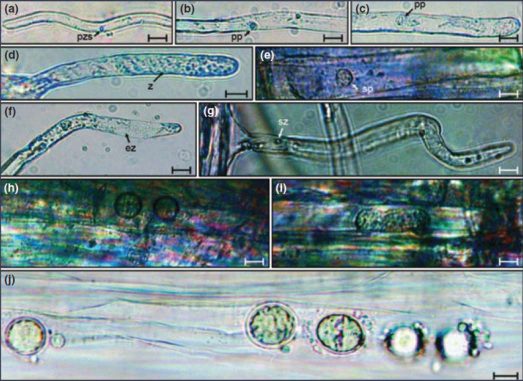Digging deeper into the clubroot-canola interaction
Key Result: Significant advances have been made in understanding the role of primary and secondary zoospores in clubroot disease development. This could contribute to new and effective sources of clubroot resistance.
Project title, Principal investigators: “The host-pathogen interaction of Plasmodiophora brassicae and canola,” Sheau-Fang Hwang, Alberta Agriculture and Forestry
Funding: Alberta Canola, SaskCanola, Manitoba Canola Growers, CCC, AAFC, GF2
While much progress has been made recently in Canada toward explaining the interactions between the clubroot pathogen Plasmodiophora brassicae and its canola host, many questions remain unanswered. These knowledge gaps need to be filled to fully understand the pathogenic and genetic diversity of P. brassicae populations, how the disease develops, infection processes, and the role of primary and secondary pathogen zoospores in disease development. This understanding will provide further tools to help manage and prevent the spread of the disease.
As part of an overall objective to produce the critical information needed to fill these important knowledge gaps, six different studies were implemented. The specific objectives of the research included:
The role of primary and secondary zoospores in infection of canola plants and in inducing host resistance.
How the pathogen invades host tissues, and what mechanisms are involved in the development of clubroot galls.
How to best define pathotypes or races of P. brassicae, and to develop molecular tools to more rapidly identify strains.
Study transformation and/or culture of P. brassicae to facilitate research into this pathogen.
RESULTS
In 2015-16 one gene, designated Cr811, was studied, which appears to be present exclusively in pathotype 5 of P. brassicae. Analysis indicated that expression of Cr811 is up-regulated during canola infection, especially in the stage of secondary plasmodia. Primers specific to Cr811 could distinguish a field isolate of P. brassicae belonging to pathotype 5 from two other field isolates representing pathotypes 3 and 8. These findings suggest that Cr811 is a gene involved in the interaction between host resistance and clubroot pathogenesis, and that it also might serve as a molecular marker for differentiation of pathotype 5 from other pathotypes.
Further work provided insights into the timing of the interaction between the effectors (causal agents) from P. brassicae and the canola host. It was found that primary infection is initiated earlier than previously believed. Additionally, primary zoospores can cause secondary infections directly, without causing primary infections. (For background information on primary and secondary infection, read the “Disease Cycle” section under the About Clubroot heading at clubroot.ca.)
The results support the hypothesis that primary infection suppresses the initiation of resistance in a susceptible cultivar and also stimulates the resistance reaction in a resistant cultivar. It appears likely that pathogen effectors are recognized at the primary infection stage and that this early interaction between host and pathogen contributes to the resistant or susceptible reaction in the host at the secondary infection stage.
To further understand the different pathotypes of P. brassicae, one-week-old seedlings of 13 Brassica genotypes were inoculated with resting spore suspensions representing each of 11 populations and 7 single-spore isolates of P. brassicae from Canada, U.S. and China. This research identified five distinct pathogen virulence groupings based on host reactions. This suggests that these different hosts may constitute an effective foundation for the development of a Canadian clubroot differential set, and will be further evaluated in order to more effectively classify pathotypes of P. brassicae.

Credit: Feng, Hwang & Strelkov, 2013
During the research studies, a modified methodology for secondary zoospore generation was developed to enable production of greater amounts of zoospores for larger scale experiments. In the future, this revised methodology may also prove useful for breeding programs that wish to screen for resistance against secondary zoospores (as opposed to resting spores/primary zoospores).
In summary, the research revolved around improving our understanding of the P. brassicae/canola interaction. Such knowledge is critical to developing sustainable clubroot management strategies, particularly as they pertain to the production and deployment of genetically-resistant canola cultivars, and the development of effective biological and chemical controls for the pathogen.
PEER-REVIEWED JOURNAL ARTICLES: * Zhang, H., J. Feng, S.J. Zhang, S.F. Zhang, F. Li, S.E. Strelkov, R.F. Sun, and S.F. Hwang. 2015. Resistance to Plasmodiophora brassicae in Brassica rapa and Brassica juncea genotypes from China. Plant Dis. 99:776-779.
Zhang, H., J. Feng, V.P. Manolii, S.E. Strelkov and S.F. Hwang. 2015. Characterization of a pathotype 5-specific gene from the clubroot pathogen Plasmodiophora brassicae. Phytopathology 105: 764-770.
Zhang H., J. Feng, S. F. Hwang, S. E. Strelkov, I. Falak, X. Q. Huang and R. F. Sun. 2016. Study of resistance to clubroot (Plasmodiophora brassicae) in a canola (Brassica napus) doubled haploid population. Can. J. Plant Pathol: 38: 133. Fei, W.X., S. Rong, J. Feng, S.F. Hwang and S. E. Strelkov. 2016. Expression patterns of selected Plasmodiophora brassicae genes in resistant and susceptible canola. Can. J. Plant Pathol: 38: 128





